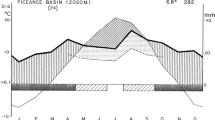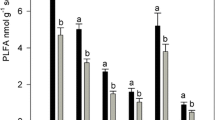Abstract
Sporadic summer rainfall in semi-arid ecosystems can provide enough soil moisture to drastically increase CO2 efflux and rates of soil N cycling. The magnitudes of C and N pulses are highly variable, however, and the factors regulating these pulses are poorly understood. We examined changes in soil respiration, bacterial, fungal and microfaunal populations, and gross rates of N mineralization, nitrification, and NH4+ and NO3− immobilization during the 10 days following wetting of dry soils collected from stands of big sagebrush (Artemisia tridentata) and cheatgrass (Bromus tectorum) in central Utah. Soil CO2 production increased more than tenfold during the 17 h immediately following wetting. The labile organic C pool released by wetting was almost completely respired within 2–3 days, and was nearly three times as large in sagebrush soil as in cheatgrass. In spite of larger labile C pools beneath sagebrush, microbial and microfaunal populations were nearly equal in the two soils. Bacterial and fungal growth coincided with depletion of labile C, and populations peaked in both soils 2 days after wetting. Protozoan populations, whose biomass was nearly 3,000-fold lower than bacteria and fungi, peaked after 2–4 days. Gross N mineralization and nitrification rates were both faster in cheatgrass soil than in sagebrush, and caused greater nitrate accumulation in cheatgrass soil. Grazing of bacteria and fungi by protozoans and nematodes could explain neither temporal trends in N mineralization rates nor differences between soil types. However, a mass balance model indicated that the initial N pulse was associated with degradation of microbial substrates that were rich in N (C:N <8.3), and that microbes had shifted to substrates with lower N contents (C:N =15–25) by day 7 of the incubation. The model also suggested that the labile organic matter in cheatgrass soil had a lower C:N ratio than in sagebrush, and this promoted faster N cycling rates and greater N availability. This study provides evidence that the high N availability often associated with wetting of cheatgrass soils is a result of cheatgrass supplying substrates to microbes that are of high decomposability and N content.







Similar content being viewed by others

References
Adu J, Oades J (1978) Physical factors influencing decomposition of organic materials in soil aggregates. Soil Biol Biochem 10:109–115
Ågren GI, Bosatta E (1998) Theoretical ecosystem ecology. Cambridge University Press, Cambridge
Appel T (1998) Non-biomass soil organic N—the substrate for N mineralization flushes following soil drying-rewetting and for organic N rendered CaCl2-extractable upon soil drying. Soil Biol Biochem 30:1445–1456
Bakken LR, Olsen RA (1983) Buoyant densities and dry-matter contents of microorganisms: conversion of a measured biovolume into biomass. Appl Environ Microbiol 45:1188–1195
BassiriRad H, Tremmel DC, Virginia A, Reynolds JF, De Soyza AG (1999) Short-term patterns in water and nitrogen acquisition by two desert shrubs following a simulated summer rain. Plant Ecol 145:27–36
Birch HF (1958) The effect of soil drying on humus decomposition and nitrogen availability. Plant Soil 10:9–31
Birch HF (1959) Further observations on humus decomposition and nitrification. Plant Soil 11:262–286
Bloem J, Ruiter PD, Koopman G, Lebbink G, Brussaard L (1992) Microbial numbers and activity in dried and rewetted arable soil under integrated and conventional management. Soil Biol Biochem 24:655–665
Bloem J, Bolhuis PR, Veninga MR, Wieringa J (1995) Microscopic methods for counting bacteria and fungi in soil. In: Alef K, Nannipieri P (eds) Methods in applied soil microbiology. Academic, London, pp 162–173
Booth MS, Stark JM, Caldwell MM (2003) Inorganic N turnover and availability in annual- and perennial-dominated soils in a northern Utah shrub-steppe ecosystem. Biogeochemistry 66:311–330
Bosatta E, Ågren GI (1991) Dynamics of carbon and nitrogen in the organic matter of the soil: a generic theory. Am Nat 138:227–245
Bottner P (1985) Response of microbial biomass to alternate moist and dry condition in a soil incubated with 14C and 15N labeled plant material. Soil Biol Biochem 17:329–337
Cabrera ML (1993) Modeling the flush of nitrogen mineralization caused by drying and rewetting soils. Soil Sci Soc Am J 57:63–66
Clarholm M (1981) Protozoan grazing of bacteria in soil—impact and importance. Microb Ecol 7:343–350
Clarholm M (1985) Interactions of bacteria, protozoa and plants leading to mineralization of soil nitrogen. Soil Biol Biochem 17:181–187
Clarholm M, Popovic B, Rosswall T, Söderström B, Sohlenius B, Staff H, Wiren A (1981) Biological aspects of nitrogen mineralization in humus from pine forest podsol incubated under different moisture and temperature conditions. Oikos 37:137–145
Clein J, Schimel JP (1994) Reduction in microbial activity in birch litter due to drying and rewetting events. Soil Biol Biochem 26:403–406
Coleman DC, Anderson RV, Cole CV, Elliott ET, Woods L, Campion MK (1978) Trophic interactions in soil as they affect energy and nutrient dynamics. IV. Flow of metabolic and biomass carbon. Microb Ecol 4:373–380
Cui M, Caldwell MM (1997) A large ephemeral release of nitrogen upon wetting of dry soil and corresponding root responses in the field. Plant Soil 191:291–299
Darbyshire JF, Wheatley RF, Greaves MP, Inkson RHE (1974) A rapid micromethod for estimating bacterial and protozoa populations in soil. Rev Ecol Biol Sol 11:465–475
DeAngelis DL (1992) Dynamics in food webs and nutrient cycling. Chapman and Hall, Boca Raton, Fla.
DiTomaso JM (2000) Invasive weeds in rangelands: species, impacts, and management. Weed Sci 48:255–265
Elliott ET, Horton K, Moore JC, Coleman DC, Cole CV (1984) Mineralization dynamics in fallow dryland wheat plots, Colorado. Plant Soil 76:149–155
Elliott ET, Hunt HW, Walter DE (1988) Detrital foodweb interactions in North American grassland ecosystems. Agric Ecosys Environ 24:41–56
Fierer N, Schimel JP (2002) Effects of drying-rewetting frequency on soil carbon and nitrogen transformations. Soil Biol Biochem 34:777–787
Fierer N, Schimel JP (2003) A proposed mechanism for the pulse in carbon dioxide production commonly observed following the rapid rewetting of a dry soil. Soil Sci Soc Am J 67:798–805
Fry JC (1990) Direct methods and biomass estimation. In: Grigorova R, Norris JR (eds) Methods in microbiology, vol. 22. Techniques in microbial ecology. Academic, London, pp 41–85
Gebauer RLE, Ehleringer JR (2000) Water and nitrogen uptake patterns following moisture pulses in a cold desert community. Ecology 81:1415–1424
van Gestel M, Ladd JN, Amato M, (1991) Carbon and nitrogen mineralization from two soils of contrasting texture and microaggregate stability: influence of sequential fumigation, drying and storage. Soil Biol Biochem 23:313–322
Halverson LJ, Jones TM, Firestone MK (2000) Release of intracellular solutes by four soil bacteria exposed to dilution stress. Soil Sci Soc Am J 64:1630–1637
Hassink J (1993) Relationship between the amount and the activity of the microbial biomass in Dutch grassland soils: comparison of the fumigation-incubation method and the substrate-induced respiration method. Soil Biol Biochem 25:533–538
Hungate BA, Lund CP, Pearson HL, Chapin FS (1997) Elevated CO2 and nutrient addition alter soil N cycling and trace gas fluxes with early season wet-up in a California annual grassland. Biogeochemistry 37:89–109
Hunt HW, Elliott ET, Walter DE (1989) Inferring trophic transfers from pulse-dynamics in detrital food webs. Plant Soil 115:247–259
Ingham ER, Trofymow JA, Ames RN, Hunt HW, Morley CR, Moore JC, Coleman DC (1986) Trophic interactions and nitrogen cycling in a semi-arid grassland soil. I. Seasonal dynamics of the natural populations, their interactions and effects on nitrogen cycling. J Appl Ecol 23:597–614
Ivans CY, Leffler AJ, Spaulding U, Stark JM, Ryel RJ, Caldwell MM (2003) Root responses and nitrogen acquisition of Artemisia tridentata and Agropyron desertorum following small summer rainfall events. Oecologia 134:317–324
Kieft TE, Soroker E, Firestone MK (1987) Microbial biomass response to a rapid increase in water potential when dry soil is wetted. Soil Biol Biochem 19:119–126
Marumoto T, Kai H, Yoshida T, Harada T (1977) Chemical fractions of organic nitrogen in acid hydrolysates given from microbial cells and their cell wall substances and characterization of decomposable soil organic nitrogen due to drying. Soil Sci Plant Nutr 23:125–134
Mary B, Recous S, Robin D (1998) A model for calculating nitrogen fluxes in the soil using 15N tracing. Soil Biol Biochem 30:1963–1979
Murphy DV, Sparling GP, Fillery IRP, McNeill AM, Braunberger P (1998) Mineralisation of soil organic nitrogen and microbial respiration after simulated summer rainfall events in an agricultural soil. Aust J Soil Res 36:231–246
Parker LW, Freckman DW, Steinberger Y, Drigger L, Whitford WG (1984) Effects of simulated rainfall and litter quantities on desert soil biota: soil respiration, microflora and protozoa. Pedobiologia 27:185–195
de Ruiter PC, Neutel AM, Moore JC (1994) Modeling food webs and nutrient cycling in agro-ecosystems. Trends Ecol Evol 10:378–383
Rudaz AO, Davidson EA, Firestone MK (1991) Sources of nitrous-oxide production following wetting of dry soil. FEMS Microb Ecol 85:117–124
Sohlenius B (1979) A carbon budget for nematodes, rotifers and tardigrades in a Swedish coniferous forest soil. Holarct Ecol 2:30–40
Soulides DA, Allison FE (1961) Effect of drying and freezing soils on carbon dioxide production, available mineral nutrients, aggregation, and bacterial population. Soil Sci 91:291–298
Sparling GP, Murphy DV, Thompson RB, Fillery IRP (1995) Short-term net N mineralisation from plant residues and gross and net N mineralisation from soil organic matter after rewetting of a seasonally dry soil. Aust J Soil Res 33:961–973
Stout JD, Heal OW (1967) Protozoa. In: Burges A, Raw F (eds) Soil biology. Academic, New York, pp 149–195
Stark JM (1991) Environmental factors versus ammonia-oxidizer population characteristics as dominant controllers of nitrification in an oak woodland-annual grassland soil. PhD dissertation, University of California
Stark JM, Hart SC (1996) Diffusion technique for preparing salt solutions, Kjeldahl digests, and persulfate digests for nitrogen-15 analysis. Soil Sci Soc Am J 60:1846–1855
Vance ED, Brookes PC, Jenkinson DS (1987) An extraction method for measuring soil microbial C. Soil Biol Biochem 19:703–707
West AW, Sparling GP (1986) Modifications to the substrate-induced respiration method to permit measurement of microbial biomass in soil of different water content. J Microbiol Meth 5:177–189
Young JA, Blank RR, Longland WR (1995) Nitrogen enrichment-immobilization to control succession in arid land plant communities. J Arid Land Studies 5S:57–60
Acknowledgements
We thank M. Larson, A. Anderson, and E. Courtright-Risley for laboratory assistance, K. Sompi for quantifying the nematodes, and J. Norton for the use of her epifluorescent microscope. J. Moore, B. Sohlenius and J. Bloem provided valuable advice on methodologies. B. Mary provided the FLUAZ software and advice on how to run it. This research was funded by a grant from the National Science Foundation (DEB 9807097) and the Utah Agricultural Experiment Station.
Author information
Authors and Affiliations
Corresponding author
Rights and permissions
About this article
Cite this article
Saetre, P., Stark, J.M. Microbial dynamics and carbon and nitrogen cycling following re-wetting of soils beneath two semi-arid plant species. Oecologia 142, 247–260 (2005). https://doi.org/10.1007/s00442-004-1718-9
Received:
Accepted:
Published:
Issue Date:
DOI: https://doi.org/10.1007/s00442-004-1718-9



